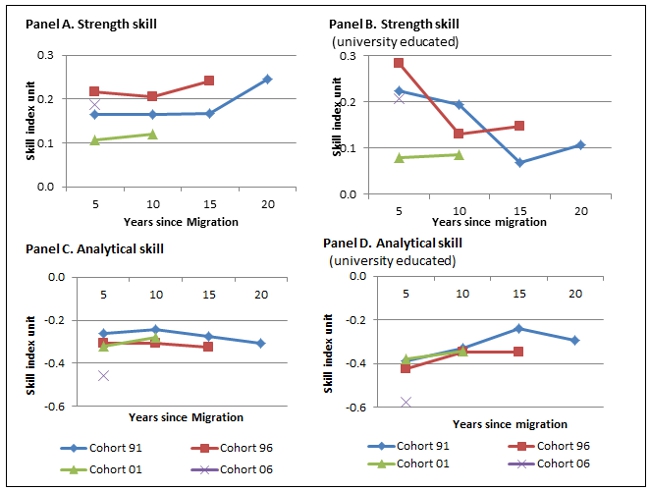
 It is a common assumption that most migrant women only enter the workforce as so-called ‘secondary workers’, supplementing the income of their husbands for a relatively short amount of time. Using data from more than 800,000 women in Canada from 1991 to 2006, Alícia Adserà and Ana Ferrer find that in their workforce participation, married women immigrants tend to fit the profile of married native women and that they experience rising wages and an increase in the amount of analytical skills needed for their work over time. They write while immigrant women experience barriers to entry into skilled occupations, these too ease over time, though not to full wage parity with native women.
It is a common assumption that most migrant women only enter the workforce as so-called ‘secondary workers’, supplementing the income of their husbands for a relatively short amount of time. Using data from more than 800,000 women in Canada from 1991 to 2006, Alícia Adserà and Ana Ferrer find that in their workforce participation, married women immigrants tend to fit the profile of married native women and that they experience rising wages and an increase in the amount of analytical skills needed for their work over time. They write while immigrant women experience barriers to entry into skilled occupations, these too ease over time, though not to full wage parity with native women.
The existing literature on the employment choices and trajectories of women in immigrant families is divided. Some researchers argue that immigrant women are secondary workers, that is, they join the labor market mostly as a response to family needs, generally because of income shocks, and become employed mainly as unskilled workers to support their husbands’ investment in local skills. As men assimilate in their destination country and, as a result, household financial constraints ease, their spouses’ participation in the labour market is expected to drop from a temporarily abnormal high to levels similar to those of native-born women. This view is, however, at odds with Blau et al’s (2003) findings among others. These researchers find that married immigrant women make labor supply decisions similar to those recently observed for native married women, who are guided by their own opportunities in the labour market rather than by their spouses’ trajectories.
Our own research supports the view that married immigrant women to Canada do not fit the profile of secondary workers, but rather conform to the recent patterns of married native women, with rising participation in the labor market and wage gains as they stay longer in Canada. We combine data for over 800,000 women in Canada from 1991 to 2006 with information on the skill requirements (such as, for example, physical strength, quantitative and interpersonal abilities) of the jobs women hold to examine the labour market patterns of immigrant women. Their behavior displays a path of assimilation similar to that of immigrant men. At best, only relatively uneducated immigrant women in jobs requiring very basic skills may fit the profile of secondary workers.
Immigrant women participate in the labour market, upon at arrival, at a much lower rate than similar native women, but this rate increases steadily over time. The average woman arriving in Canada during the first half of the 1990s is only 34 percent as likely to enter the labor market as her Canadian-born counterpart during her first 5 years in the country, but 72 percent as likely after being in Canada 15 to 20 years. This pattern of rising engagement in the labor market by immigrant women does not conform with a need to temporarily support the household upon migration, but rather with a labour market assimilation process similar to what is found for immigrant men.
However, immigrant women participate in occupations requiring relatively low skills at a much higher rate than similarly-educated Canadian women do and this gap rises over time. This is true even for the university-educated immigrants who nowadays constitute a large fraction of the immigrant population as a result of Canada’s selective immigration policy. While the fact that immigrant women are overrepresented in unskilled jobs at arrival appears to agree with the view that they are secondary workers, it is not as easy to interpret their rising relative participation in those jobs over time. This ambiguity is due to the fact that in our data we cannot track the same individual women over time, but rather in each Census we use women with similar characteristics who arrived to Canada around the same time. Thus this pattern could result, for instance, from some immigrant women leaving unskilled jobs over time and being replaced by women from the same cohort who were not working before, or some women initially holding high skill jobs losing these jobs and re-entering the labour market as low skill workers. Both hypotheses, however, seem unlikely, because we find significant wage gains over time for women in unskilled occupations relative to the native-born. This would be hard to reconcile with these patterns of behaviour.
Overall wages of highly-educated immigrants during their first five years in Canada stand between 40 to 65 percent below those of educated native-born women, but are only around 26 percent below 10 to 15 years after migration. Immigrants without any college education experience slower, but more complete wage gains. Their wages go from being around 18 to 33 percent below those of the similarly-educated native-born upon arrival to 6 to 9 percent lower 10 to 15 years after migration.
A better way to observe the progression of educated immigrant women in the Canadian labor market over time is to look at the evolution of the skills required for the jobs they hold. We find an increasing integration into the labor force over time: a reduction in the need for physical strength and a gradual increase in the relative amount of analytical skills required in their jobs. Figure 1 follows the skill needs of the jobs held by different arrival cohorts of immigrant women relative to those of natives (represented by the zero) over time. A unit of the skill score can be interpreted as one standard deviation in the skill distribution of the Canadian-born population. The index increases with either the physical strength or analytical demands of the job. Panels A and C do not show any assimilation in analytical or strength requirements for immigrant women over the years in Canada — rather a flat or even worsening pattern relative to natives.
In panels B and D we repeat the analysis for university-educated women and find some assimilation in analytical skills and a much sharper movement out of jobs requiring relatively higher levels of physical strength than those held by natives. During the first five years in Canada, jobs held by the ‘96 cohort, for example, require strength skills around 0.3 standard deviations above those held by natives with similar characteristics, but that gap shrinks down to 0.15 standard deviations or less in the following years. Our findings on skill mobility suggest that most of the career progression of educated immigrant women is related to switches in the tasks required for their jobs.
Figure 1 – Estimated skill requirements of jobs held by immigrant women relative to similar natives, by arrival cohort and years in Canada.

Note: The vertical axis measures differences in standard deviations from the skill level of similar natives.
Our findings have significant policy implications. How policy-makers perceive the strength of the labor market attachment of immigrant women affects the range of support services they might deem necessary to provide. Moreover, a large presence of educated immigrant women in low-skilled occupations suggests the existence of significant obstacles at entry. However, judging by the gradual convergence between the tasks required for their jobs and those of natives, these barriers seem to ease over time and lead to some wage assimilation (although far from reaching wage parity even after 15 to 20 years in Canada). In countries with immigration policies that place strong emphasis on human capital, policy-makers need to recognize the difficulties in the advancement of immigrant women if they want to take full advantage of their potential. For the less-educated, skill progression does not happen; although wages still rise gradually over time reaching 90 percent of the wages of similarly-educated native women.
This article is based on the paper ‘The Myth of Immigrant Women as Secondary Workers’ in the American Economic Review.
Featured image credit: Cohen Canada (Creative Commons BY SA)
Please read our comments policy before commenting.
Note: This article gives the views of the author, and not the position of USApp– American Politics and Policy, nor of the London School of Economics.
Shortened URL for this post: http://bit.ly/T5zi9v
_________________________________
 Alícia Adserà – Princeton University, USA
Alícia Adserà – Princeton University, USA
Alícia Adsera is a Research Scholar and Lecturer in Economics at the Woodrow Wilson School and faculty affiliate at the Office of Population Research, at Princeton University. She is also a research fellow at the Centre for Research and Analysis of Migration (CReAM), University College London and at IZA (Bonn). Her research interests are in economic demography, development and international political economy. Her recent work focuses on the role of labor market institutions and economic conditions on fertility and household formation as well as in an array of migration topics.
 Ana Ferrer – University of Waterloo, Canada
Ana Ferrer – University of Waterloo, Canada
Ana Ferrer is an associate professor at the University of Waterloo and associated researcher at the Canadian Labour and Skills Research Network (CLSRN) and the Centre for Research and Analysis of Migration (CReAM). She graduated from Boston University and her research career developed in Canada, and focused on immigration, education and family economics. Her work on the economics of education includes research on different aspects of the premium attached to immigrant credentials and to the skills brought by immigrants to Canada. More recently, her work has focused on the fertility of immigrants and its consequences for immigrant integration.



